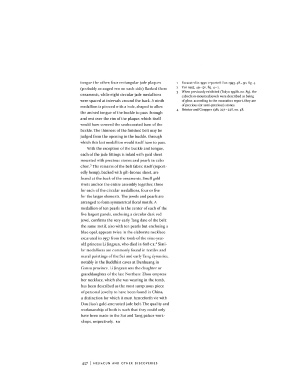Page 458 - The Golden Age of Chinese Archaeology: Celebrated Discoveries from the People’s Republic of China
P. 458
tongue the other; four rectangular jade plaques 1 Excavated in 1992; reported: Yun 1993, 48-50, fig. 4.
(probably arranged two on each side) flanked these 2 Yun 3993, 49 - 50, fig. 4-2.
3 When previously exhibited (Tokyo 1998^ no. 89), the
ornaments, while eight circular jade medallions cabochon-mounted jewels were described as being
were spaced at intervals around the back. A ninth of glass; according to the excavation report, they are
medallion is pierced with a hole, shaped to allow of precious (or semi-precious) stones.
4 Brinker and Goepper 1981, 227- 228, no. 48.
the arched tongue of the buckle to pass through
and rest over the rim of the plaque, which itself
would have covered the undecorated base of the
buckle. The thinness of the finished belt may be
judged from the opening in the buckle, through
which this last medallion would itself have to pass.
With the exception of the buckle and tongue,
each of the jade fittings is inlaid with gold sheet
mounted with precious stones and pearls in cabo-
3
chon. The remains of the belt fabric itself (report-
edly hemp), backed with gilt-bronze sheet, are
found at the back of the ornaments. Small gold
rivets anchor the entire assembly together, three
for each of the circular medallions, four or five
for the larger elements. The jewels and pearls are
arranged to form symmetrical floral motifs. A
medallion often pearls in the center of each of the
five largest panels, enclosing a circular dark red
jewel, confirms the very early Tang date of the belt:
the same motif, also with ten pearls but enclosing a
blue opal, appears twice in the elaborate necklace
excavated in 1957 from the tomb of the nine-year-
4
old princess Li Jingxun, who died in 608 CE. Simi-
lar medallions are commonly found in textiles and
mural paintings of the Sui and early Tang dynasties,
notably in the Buddhist caves at Dunhuang in
Gansu province. Li Jingxun was the daughter or
granddaughter of the last Northern Zhou empress:
her necklace, which she was wearing in the tomb,
has been described as the most sumptuous piece
of personal jewelry to have been found in China,
a distinction for which it must henceforth vie with
Dou Jiao's gold-encrusted jade belt. The quality and
workmanship of both is such that they could only
have been made in the Sui and Tang palace work-
shops, respectively. RW
457 | H E J I A C U N AND O T H E R D I S C O V E R I E S

